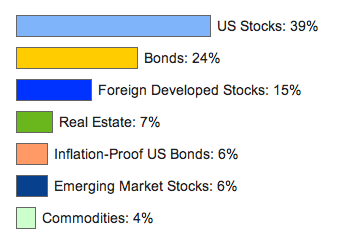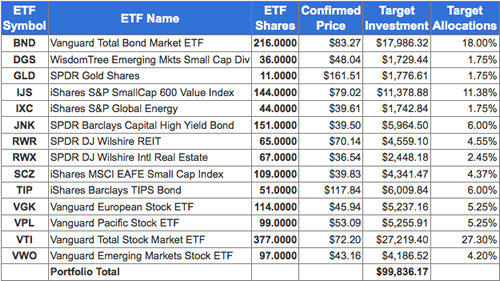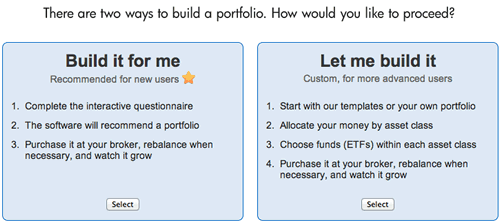Time to try out another online portfolio manager – MarketRiders.com. While previously-reviewed Betterment is an website/broker/advisor combo that handles all the decisions and trade executions for you, MarketRiders is more like an online portfolio coach telling you what trades to place yourself at the discount broker of your choice. Both services offer diversified portfolios using low-cost index ETFs, but think of it as one cooks you a nice tray of lasagna while the other one provides you a detailed, step-by-step recipe.
Free Trial Sign-up
To find out what the recipe is, you have to sign up for a free 30-day trial with your credit card information. The regular price for the service is $149.95 a year or $14.95 per month. You will be auto-enrolled after 30 days, but MarketRiders promises that canceling is easy and can be done completely online within two clicks. I can confirm it is indeed that easy. Just go to My account > Manage my subscription > Cancel my subscription. You still even get to use the rest of your free 30 days after canceling. Now, what do you get?
(Update: It looks like you can get $25 off the annual fee with coupon code MR25OFF.)
Asset Allocation
First up, you’ll need a target asset allocation. You can either provide your own, or MarketRiders can recommend one based on a risk questionnaire. (Ah, the same old risk questionnaire everyone uses because a better alternative has not been discovered. Research has shown that how much people like risk is pretty much dependent on how well the market has done recently.) In any case, I said I was a “medium risk” 33-year old that wants to retire by age 50 with $100,000 to invest.
Here are the target asset allocation (70% stocks/30% bonds) and specific ETF purchases they assigned me.


One neat feature is that the your ETF portfolio is tweaked slightly based on what brokerage you wish to use, as some brokers offer commission-free ETFs from certain companies. Curiously enough, even though many of the ETFs recommended were from Vanguard, using discount broker TD Ameritrade instead of going in-house with Vanguard would actually cost me less money in commission as their 100 free ETF list includes all the Vanguard ETFs as well as several iShares ETFs.
Rebalancing
So, you buy the ETFs that are recommended. That’s easy enough, but the real long-term benefit of MarketRiders is the ability to keep rebalancing your portfolio to keep it closely aligned with your target asset allocation throughout market cycles. It’s easy to be swayed by market forces and stop buying stocks in a bear market, only to miss the surprise bullish moves (like recently!). You want to manage your emotions when investing, and following directions given to you by an objective third party will help you do that.
However, to do this you’ll have to update MarketRiders whenever you make an additional purchase and provide your trade information (# of shares, execution price).
Likes and Dislikes
I like the goal and intent of MarketRiders. I like low-cost, diversified portfolios. I like the ability to enter a custom portfolio. I like rebalancing regularly to maintain the right risk profile and to combat behavioral weaknesses. I like the idea of a unbiased “coach” telling me what I need to do at a reasonable price. I like the free trial to check out their designed portfolios.
The main problem that I see with this service is that people are lazy. I know I am. I read and write about personal finance every day and even I only rebalance my portfolio at most a few times a year. To do this, I made my own Google Docs spreadsheet and check in every quarter by just adding up all my holdings in each asset class.
I don’t like the idea of having to enter every trade that I make manually. I make lots of trades every month, through various accounts including 401k purchases. I feel that MarketRiders should license the same aggregation tools that other sites use (like Personal Capital) to see my portfolio details without any manual entry. Otherwise, I don’t like the idea of paying $150 a year to do something I’ve already been doing on my own for free with roughly the same amount of time and effort.
If MarketRiders seamlessly synced with all my brokerage accounts and saved me time and effort by telling me when to rebalance things inside my entire portfolio spread across IRAs and 401ks and Solo 401ks, I think I would pay $99 a year in exchange for that service (if only as a double-check to my current practices). But with all the extra work required, it’s hard for this DIY investor to justify the price. I really hope they take my advice on adding account aggregation.
For the same reasons, I think the newbie investor would rather go with Betterment or a Vanguard Target Retirement fund instead as well. MarketRiders charges $150 a year + commissions, which is much more than Betterment would charge until you reached portfolio sizes of well over $60,000.

 The Best Credit Card Bonus Offers – 2025
The Best Credit Card Bonus Offers – 2025 Big List of Free Stocks from Brokerage Apps
Big List of Free Stocks from Brokerage Apps Best Interest Rates on Cash - 2025
Best Interest Rates on Cash - 2025 Free Credit Scores x 3 + Free Credit Monitoring
Free Credit Scores x 3 + Free Credit Monitoring Best No Fee 0% APR Balance Transfer Offers
Best No Fee 0% APR Balance Transfer Offers Little-Known Cellular Data Plans That Can Save Big Money
Little-Known Cellular Data Plans That Can Save Big Money How To Haggle Your Cable or Direct TV Bill
How To Haggle Your Cable or Direct TV Bill Big List of Free Consumer Data Reports (Credit, Rent, Work)
Big List of Free Consumer Data Reports (Credit, Rent, Work)
Thanks for this article. I have a few questions which, hopefully, people can help me with:
1. Am I correct in assuming that if I use Marketriders, my funds can remain in their present account and need not be transferred to Marketriders or a brokerage of their choosing?
2. Marketriders suggest some ETFs that other advisors don’t, such as high yield bonds and energy ETFs. Is there someplace to compare Marketriders’ portfolio performance against the performance of other managed ETF portfolio advisors who offer different portfolio allocations, perhaps with fewer ETFs? Many people say just pick an ETF allocation and stay with it. I’d prefer to pick one that has done better, over perhaps a 10 year time period.
3. Is Marketriders’ service essentially the same as that provided by futureadvisors.com, but with Futureadvisors using fewer ETFs. Again, it would be interesting to compare various ETF advisors’ perfomance over time.
Thanks!
Would you ever look at an offline tool? Is the aggregation a deal-breaker for you?
What if, instead of entering every transaction, you only had to enter share qty / account balance when it was time to update? That’s what I do with my spreadsheet, and it takes maybe 10-15 minutes when I do a quarterly update.
I ask because I’m building a tool (for offline use) that will have some similar features, and I’m wondering exactly which features I should target first.
Nice breakdown… it seems like it would be worth it for someone starting out or considering switching brokers to use the free trial to set up their initial allocation and then track it on your own.
I recently switched to Schwab for all my assets, but in hindsight wish I had gone with TD Ameritrade. The 100 free ETF list is pretty impressive and the Schwab Free ETFs, which cover most of the basic asset classes, are extremely low on volume. Regardless, I was trying to come up with a list of best ETFs for my initial investment and MarketRiders seems useful for that.
@TedF –
1. Yes, MarketRiders does not use a custodian and currently at least does not actually handle portfolio assets themselves.
2. The MR portfolio is a little “busy” but they do provide some backtested results when they present it to you. You may want to try out the free trial to check it out.
3. I haven’t checked out FutureAdvisors yet, but it’s on my To Do list.
@Brian – I’m a DIY investor at heart, so I don’t think I’m going to pay for a full financial advisor anytime in the foreseeable future. However, I would pay for a time-saving tool. Something that took into account all my assets and helped me rebalance towards my custom target asset allocation and would give me a instant overview of everything. I think aggregation is pretty critical for the latter part, unless a really easy import system was available.
@Maury – Yes, it was interesting to see their recommended portfolio. I can understand why they choose each one, but 14 different ETFs felt like a lot.
“What to look for in an active investment manager” An interesting article in the “Wealth Matters” section of the March 30, 2012 online New York Times. Not sure how to place a link here. Seems to suggest that managed ETF portfolios are the way to go.